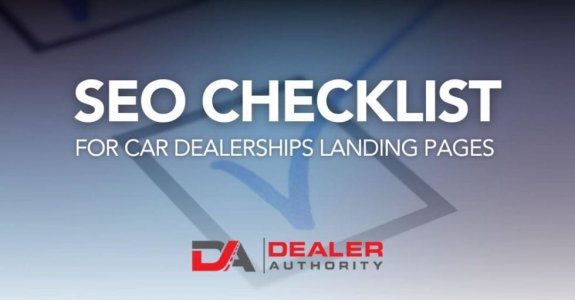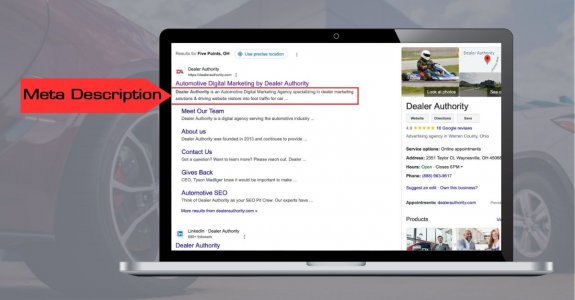- Jun 1, 2018
- 89
- 75
- Awards
- 5
- First Name
- Brian

Your dealership’s online success begins with a robust SEO strategy. By integrating SEO best practices for your car dealership landing pages, you can increase both traffic and conversions.
Optimizing landing pages for search engines is crucial for car dealerships to capture more leads and increase sales. As masters of digital marketing and SEO, the team at Dealer Authority put together an SEO checklist for car dealership landing pages. With these SEO best practices, you can ensure customers find your website and turn visitors into buyers.
The cornerstone of any effective SEO strategy is choosing the right keywords. It’s especially true in the highly competitive automotive market, where the right phrases can drive traffic, and the wrong ones might lead nowhere. For car dealerships, this typically means focusing on both transactional keywords that signal buying intent, like “Buy Toyota Camry San Diego,” and specific keywords that connect with local customers.
If you’re located in Naples and specialize in electric vehicles, your keywords might include “Naples electric car sales” or “buy electric vehicles Naples.” Including these terms naturally within your website’s content, titles, and meta descriptions can significantly improve your visibility in search results. For instance, instead of naming a page simply “Our Cars,” a more effective title might be “Affordable Electric Cars in Naples.”
By embedding these keywords into high-impact areas of your car dealership landing page, you ensure that your dealership shows up on their radar when a potential customer searches for these terms.
Enhancing Content Quality
When creating the content for your dealership’s landing pages, think beyond the standard specs and features list. Your content should engage directly with the shopper’s interests and needs by answering their common questions. Consider a page that lists the benefits of a hybrid vehicle and explains how it fits into a sustainable lifestyle.For example, rather than a simple bullet list of features for the latest SUV model, you could describe how the vehicle’s safety enhancements are ideal for new families. Use real-life scenarios that connect to your audience, like detailing a day in the life of a family using the vehicle. This approach helps potential buyers visualize their lives with the vehicle, making the content more relatable and effective.
Use Effective CTAs
The ultimate goal of your landing page is to convert visitors into sales. Clear and compelling calls to action (CTAs) play a massive role in guiding potential customers through this process.Whether it’s a button saying “Book a Free Test Drive Today” or a form inviting visitors to “Sign Up for Exclusive Offers,” each CTA should be straightforward and tied to an immediate benefit. For instance, placing a “Get More Info” button at the end of a vehicle review can direct readers towards contacting your sales team, effectively moving them down the sales funnel.
User Experience and Page Performance
Page speed is not just a technical metric; it directly influences user satisfaction and SEO rankings. A slow-loading page can be a quick turn-off for potential buyers, increasing bounce rates and reducing the effectiveness of your SEO efforts. Tools like Google’s Page Speed Insights can analyze your site and provide actionable recommendations to improve speed.Navigation also plays a big role. A well-structured landing page with intuitive navigation helps visitors quickly find the information they need, without frustration. For example, if your landing page includes links to vehicle comparison charts, make sure these links are noticeable and accessible.
Functional Navigation with Internal Linking
Internal linking is the secret to a website that works like a well-oiled machine. Make sure each page on your site is connected with others through meaningful anchor text. Think of it like a city map where every street sign is clear and points you to popular destinations — like your contact page or special offers. For instance, if you mention the durability of a truck, link that text to your page on off-road accessories.Mobile-Friendly
Your website needs to keep up with people on the go. That means your landing page should look good and function well on any device, from a desktop to a smartphone. Imagine your customers checking out your site while at a coffee shop or in between errands. A mobile-friendly design ensures they have a hassle-free experience wherever they are.Build Trust with Social Proof
Social proof on your website can be a powerful influence. You should feature customer testimonials, industry awards, certifications, and reviews prominently. You aren’t just announcing that “Best Dealership” award; you’re showing potential buyers that other people’s experiences at your dealership have been positive, giving them the confidence to choose you.Technical SEO Essentials for Car Dealership Landing Pages
URL Structure
You’ll need to get technical to ensure your dealership’s landing pages are as SEO-friendly as possible. Make your URLs clean, concise, and descriptive. For instance, instead of a URL ending in “?p=1234,” it should look something like “/2024-toyota-camry-hybrid-san-diego”. Sure, this helps with SEO, but it also improves user experience.Header Tags
Next, focus on header tags. Your main page title should use an H1 tag and include your primary keyword, while subheadings like H2 and H3 can guide readers through your content and help search engines understand the structure of your page.Meta Description
Meta descriptions are also important, and possibly more than you even realize. A meta description should offer a clear and enticing summary of the page’s content, effectively incorporating the primary keyword to improve click-through rates from search results. Keep in mind that meta descriptions should ideally be less than 160 characters in total.Don’t let traffic slip away from your car dealership landing pages by failing to write your meta descriptions!

If you don’t take the time to write an effective and catchy meta description, search engines will randomly create one based on the text from your page. While at a glance this might seem like a nice thing to fall back on, what search engines won’t do is ensure the text is relevant or appealing to the user. This may cause searchers to shy away from your content for a result with a more compelling and/or accurate meta description.
Image Alt Tags
Don’t forget to include alt tags for your images. These descriptions help search engines understand what the images represent, helping the overall SEO of the page. An image of a family loading groceries into a car could have an alt tag of “2024 Honda CR-V cargo space demonstration.”This best practice also lends to image SEO when you incorporate your primary keywords in the alt text.
For example, suppose you have written a comparison article titled “2024 GMC Terrain vs 2024 Chevrolet Equinox.” The title can be used as the alt tag for your primary image. This helps support the primary theme of your article and gives your content another way to shine in search results.
In a vehicle comparison, searchers will likely want to know what the two cars look like, making this particular title highly relevant to image search. By using the title as the alt text, now when someone goes to search “2024 GMC Terrain vs 2024 Chevrolet Equinox,” your image will appear at the top of image searches in Google, making your content a top pick.





